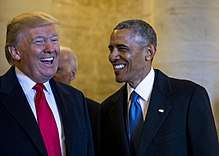Obama-Trump voters
In the United States, Obama-Trump voters, also known as Trump Democrats or Obama Republicans, voted for Democratic Party nominee Barack Obama in the 2008 or 2012 presidential elections (or both), but later voted for Republican Party nominee Donald Trump in 2016. These voters comprise 13% of Trump voters and 9% of Obama voters.[1] In contrast, 7% of Obama voters did not vote and 3% voted for a third party candidate.[1]

While some analysts consider them to have been decisive in Trump's victory, others have disputed this conclusion. Compared to other voters, Obama-Trump voters tend to have liberal economic views and conservative social views. They expressed skepticism of congressional Republicans and a desire to change the status quo.
Studies
A study by the Democracy Fund Voter Study Group found that 9.2% of Obama voters voted for Trump in 2016.[2] According to the American National Election Study, 13% of Trump voters had voted for Obama in 2012.[3] Some analysts have argued that these voters had a disproportionately large impact on the 2016 election because they were concentrated in key swing states in the Midwest while others have said they were actually "Obama Republicans" rather than Democrats to begin with.[2][4] A May 2017 analysis by Global Strategy Group estimated that Obama-Trump voters accounted for more than two-thirds of Hillary Clinton's loss.[5]
Significance
Dana Milbank has disputed both the quantity and the significance of Obama-Trump voters in deciding the outcome of the 2016 election. Milbank argued in an August 2017 Washington Post column that the number of such voters was initially overstated and that most of them were Republicans who only defected from their party to vote for Obama, not Democrats who defected to support Trump.[6] Nate Cohn responded to Milbank's criticism by arguing that Milbank's focus on national data obscured the magnitude of Democratic defection to support Trump. Cohn noted that when looking specifically at white Obama voters with no higher education than a high school diploma, Clinton won only 74% (based on data from the Democracy Fund Voter Study Group) or 78% (based on the Cooperative Congressional Election Study).[2]
Voters' views
Shortly before the 2016 election, The New York Times reported that Obama voters who now planned to vote for Trump felt he was now the embodiment of the "change" they had hoped for when they voted for Obama.[7] Multiple focus groups of Obama-Trump voters convened by the Roosevelt Institute and Democracy Corps in early 2017 showed that in general these voters wanted to change the status quo and had skeptical views of Congressional Republicans and their proposals. The same focus groups also indicated that these voters hoped President Trump would help reduce health care costs for working-class Americans and that they were anxious about some immigrant groups.[8] A survey conducted by the Democracy Fund Voter Study Group found that Obama-Trump voters generally had liberal views on economic issues, but conservative views on social issues.[9] Data from the CCES indicate that 75% of Obama-Trump voters supported repealing and replacing the Affordable Care Act.[4]
Support for President Trump
A September 2017 poll found that 70% of Obama-Trump voters approved of the job Trump was doing as president. This figure was significantly lower than the 88% approval rating among all Trump voters. Similarly, the percent of voters who disapprove of Trump's performance in this poll was much higher among Obama-Trump voters (22%) than among Trump voters as a whole (9%).[10]
See also
References
- Bump, Philip (March 12, 2018). "4.4 million 2012 Obama voters stayed home in 2016 — more than a third of them black". The Washington Post. Retrieved June 28, 2020.
- Cohn, Nate (2017-08-15). "The Obama-Trump Voters Are Real. Here's What They Think". The New York Times. ISSN 0362-4331. Retrieved 2018-02-25.
- Dent, David (2017-09-20). "Regretful Trump Voters: 'I Don't Understand How It Could Be Worse'". Vice. Retrieved 2018-02-25.
- Levitz, Eric (2017-08-16). "Trump Democrats Are Rare—But Electorally Important". Daily Intelligencer. Retrieved 2018-02-25.
- Levitz, Eric (2017-05-02). "Autopsy: It Was Obama-Trump Voters, in the Rust Belt, With the Economic Anxiety". Daily Intelligencer. Retrieved 2018-02-25.
- Kilgore, Ed (2017-08-04). "There May Not Be As Many 'Trump Democrats' As Previously Imagined". Daily Intelligencer. Retrieved 2018-02-25.
- Alcindor, Yamiche (2016-11-02). "Some Who Saw Change in Obama Find It Now in Donald Trump". The New York Times. ISSN 0362-4331. Retrieved 2018-02-25.
- "Focus Group: Obama-to-Trump Voters Expect Change, Don't Trust GOP to Deliver". Roosevelt Institute. 2017-03-15. Retrieved 2018-02-25.
- "Democrats are unlikely to win back Obama-Trump voters. But they should still have an economic agenda to help them". Vox. 2017-06-16. Retrieved 2018-02-25.
- "Poll: Obama-Trump voters drifting away from the president". Politico. 2017-09-06. Retrieved 2018-02-25.